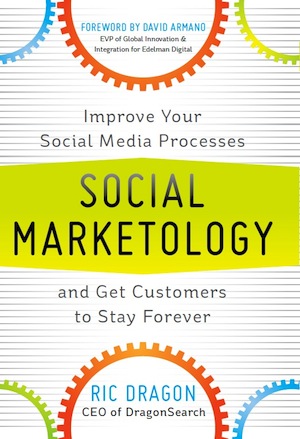
I just read Social Marketology by Ric Dragon, and I have to say, I love business books like this. It’s intelligent and practical, written in a direct yet entertaining style, and delivers meaty ideas that you can put into practice pretty much immediately.
First, full disclosure, McGraw-Hill sent me a free copy of the book to review. But life is too short to read bad books, so I wouldn’t have made it past a casual flip-through if it didn’t prove compelling.
Social Marketology is a guide to the management of social media marketing. The emphasis is on the word management. While there are plenty of books out there that evangelize the virtues of social media at a 50,000-foot level, Social Marketology comes out of the clouds to talk about how to actually run such marketing programs effectively. The book’s subtitle says “improve your social media processes,” and the book focuses a lot on process and organizational structure.
Ric draws from a rich and eclectic set of influences for his vision of modern marketing management — value chain concepts, SMART goals (specific, measurable, attainable, relevant, time-bound), the net promoter score, capability maturity models such as the community maturity model, persuasion psychology, etc. — and weaves them into a cohesive and approachable narrative.
One of my favorite parts of the book is a 6-page discussion of how to adapt Scrum agile management to social media projects. As I mentioned in a recent Search Engine Land column, Have You Adopted Agile Marketing Yet?, there’s a real Renaissance of agile marketing underway. As he does with the rest of the book, Ric does a great job of succinctly connecting the theory to concrete social media marketing management.
I also enjoyed Ric’s discussion of microsegments (microaudiences, hypersegmentation, hypergranular segmentation, whichever you prefer), including the concept of “parallel audiences.” This certainly makes sense in the context of social media marketing strategy, where specificity is key to identifying niche communities and the influencers within them. However, as with agile management, these principles are applicable to modern marketing much more broadly. The brainstorming exercise described in the book is something that all marketers should do regularly.
This leads into a terrific discussion about finding and winning over these audiences. There’s a whole chapter dedicated to “chasing the whales” — the art and science of persuading influencers in communities (as well as becoming an influencer yourself).
One other part of the book that I found particularly intriguing was a framework for categorizing patterns in social media platforms. It looks at nine devices that impact the dynamics of different social networks, from Twitter and Facebook, to Flickr and YouTube:
- identity — how people/organizations are uniquely identified
- relationships — ways people establish relationships between each other
- conversations — how communications between people happen
- groups — how people can aggregate into affinity groups
- gaming — games that can be played (seriously or casually) in the system
- presence — how to know when someone is “present” online or in person
- curation — mechanisms by which people can share content
- reputation — devices for the establishment of status
- gifting — a means for people to give to one another, often just small tokens of status or recognition (e.g., like, follow, favorite, +1, etc.)
Different social media platforms have varied strengths and weaknesses among these devices, and their implementations often differ significantly. Aside from being theoretically interesting, Ric uses this framework to help marketers determine the best way to engage with these different platforms and match the right platform to the right mission.
I’d happily recommend this book for a good weekend read to come into Monday loaded with inspiration.



